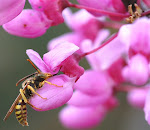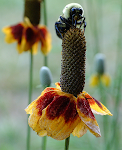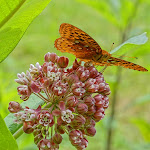Friday, October 30, 2009
Happy Halloween
Bee safe out there ya'll.
Wednesday, October 28, 2009
Air circulation and feeding in winter
from http://basicbeekeeping.blogspot.com/
LESSON 66: Screen Bottom Boards In The Winter & Fall & Winter Feeding
In a previous lesson, I shared several approaches on how to prepare for winter. In this lesson I want to go into more detail about screen bottom boards and winter feeding.
 Screen bottom boards prove to be very beneficial in the summer for reducing mites and for increasing ventilation. But do they pose a threat to a colony during the winter? That's a debated issue. Some cover their screen bottom boards while others leave them open. A few years ago, we did a simple test. We placed covers over 3 colony's screen bottom board and left the others open. We lost all three that were covered. So we always leave our screen bottom boards open all winter. It is our opinion that an open screen bottom board cuts down on excessive moisture. Cold air sinks and warm air rises, so the threat of an open screen bottom board, in our opinion, is minimal.
Screen bottom boards prove to be very beneficial in the summer for reducing mites and for increasing ventilation. But do they pose a threat to a colony during the winter? That's a debated issue. Some cover their screen bottom boards while others leave them open. A few years ago, we did a simple test. We placed covers over 3 colony's screen bottom board and left the others open. We lost all three that were covered. So we always leave our screen bottom boards open all winter. It is our opinion that an open screen bottom board cuts down on excessive moisture. Cold air sinks and warm air rises, so the threat of an open screen bottom board, in our opinion, is minimal.If your hive is up in the air 6 or 8 inches, then you want to prevent cold wind from curling up and blowing onto the cluster. This can be accomplished by building a wind block around your hive.
Remember, that a winter cluster warms only the cluster and not the inside of the hive. On an extremely cold night, the air several inches away from the cluster will be the same as outside the hive. The bees consume honey, and vibrate by flexing their muscles to generate heat, much like we do when we shiver. That heat is transferred throughout the cluster. They will be able to accomplish generating the cluster heat with or without the screen covered.
WHAT ABOUT WINTER FEEDING?
Many beekeepers allow their colonies to become extremely undernourished. Pollen and stored honey is essential to winter survival of colonies. In the fall, I work to beef up my colonies. It's tricky for me because of the number of colonies in one location. Even an inside top feeder can create a robbing frenzy. In the fall, boardman feeders placed in the front of hives is a certain robbing disaster.
So my approach is two fold. 1) During the fall only, after most nectar is no longer available, I want to prevent robbing, and 2) I want to beef up my colony nutrition for winter.

You can click on the images for a larger view. My approach is simple. I do use boardman feeders, but I place them on stands throughout the bee yard. And on dry days, I pour dry pollen out on the feed stands. My sugar mix is two parts sugar and one part water for fall. I have to make the holes bigger in the lids for the syrup to pass through. I also add one teaspoon of Honey-B-Healthy. Also, notice the bees on top of the jars? I make sugar patties too.
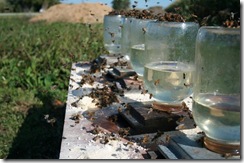 I mix sugar syrup with powdered sugar until it mixes a little stiffer than play dough. The bees love these sugar patties. I placed one on the top of each jar as you can see in the picture.
I mix sugar syrup with powdered sugar until it mixes a little stiffer than play dough. The bees love these sugar patties. I placed one on the top of each jar as you can see in the picture.So my fall feeding consist of dry pollen, hard sugar patties and 2:1 sugar syrup. Several people have asked me what 2:1 sugar means in measurements. I fill a gallon jar with between 32-48 ounces of very hot water. Then, I add sugar until it reaches the top which is around 7-8 pounds. Then stir it up. I will continue this type of feeding until the bees are clustered for winter.
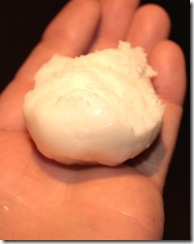 Another very effective winter feeding method is to make the sugar patties I mentioned above and lay on the tops of frames just above the cluster. Because it is a solid sugar feed, you do not have to worry about it freezing. The heat of the cluster will keep it warm and eatable.
Another very effective winter feeding method is to make the sugar patties I mentioned above and lay on the tops of frames just above the cluster. Because it is a solid sugar feed, you do not have to worry about it freezing. The heat of the cluster will keep it warm and eatable.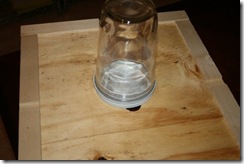 As the weather warms up above freezing, you can place pale feeders in the hive. I sometimes place jars of sugar water over the inner cover hole and then place a deep hive body without the frames so that the bees can consume the sugar water when it warms enough for the bees to break cluster. The deep hive body serves as a spacer around the jar. The top cover goes above the deep hive body spacer.
As the weather warms up above freezing, you can place pale feeders in the hive. I sometimes place jars of sugar water over the inner cover hole and then place a deep hive body without the frames so that the bees can consume the sugar water when it warms enough for the bees to break cluster. The deep hive body serves as a spacer around the jar. The top cover goes above the deep hive body spacer.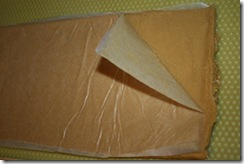 Another important feed application is that of internal pollen patties. If pollen sources are low within a colony, brood patties should be placed above the cluster. Again, on warmer winter days, the cluster will loosen enough so that bees can feed upon the pollen patties which contain a pollen substitute allowing the bees to consume the protein, vitamins, lipids and amino acids they need. ALWAYS leave the wax paper on the patty. The bees will eat around it, and usually they consume the paper too. If you remove the wax paper, the patty can become moldy and too gooey and fall between the frames.
Another important feed application is that of internal pollen patties. If pollen sources are low within a colony, brood patties should be placed above the cluster. Again, on warmer winter days, the cluster will loosen enough so that bees can feed upon the pollen patties which contain a pollen substitute allowing the bees to consume the protein, vitamins, lipids and amino acids they need. ALWAYS leave the wax paper on the patty. The bees will eat around it, and usually they consume the paper too. If you remove the wax paper, the patty can become moldy and too gooey and fall between the frames.We do sell the sugar patties, pollen patties as well as the screen bottom boards. Give us a call if you need these items or other beekeeping items.
 As we head for the end of the year, I do want to remind everyone that each year we raise our prices on January 1. We are currently offering our complete hive, which consists of a screen bottom board, two deep hive bodies with frames and foundation, one medium super with frames and foundation, an inner cover and a telescoping top cover with aluminum for $179. $170 if you purchase more than one. This price is only good through December 31, 2009. Feel free to order your hives for the spring by calling us at 217-427-2678. We take credit cards over the phone, or you can order online by clicking here.
As we head for the end of the year, I do want to remind everyone that each year we raise our prices on January 1. We are currently offering our complete hive, which consists of a screen bottom board, two deep hive bodies with frames and foundation, one medium super with frames and foundation, an inner cover and a telescoping top cover with aluminum for $179. $170 if you purchase more than one. This price is only good through December 31, 2009. Feel free to order your hives for the spring by calling us at 217-427-2678. We take credit cards over the phone, or you can order online by clicking here.We always appreciate your business, whether it is for your woodenware hive needs, queens, packages, nucs, clothing or extraction equipment, we always appreciate your loyalty.
Here's how you can contact us:
Phone: 217-427-2678
Email: david@honeybeesonline.com
Web Address: www.honeybeesonline.com
Corn Syrup linked to bee colony collapse
Government researchers have found that high-fructose corn syrup, which is used as a sweetening agent in thousands of products, creates potentially dangerous levels of a toxic substance when heated.
The scientists – from USDA’s Agricultural Research Service in Tuscon and New Orleans and at the University of Wisconsin – were searching for a possible cause of Colony Collapse Disorder, a mysterious disease that has killed at least one-third of the nation’s commercial bees.
The team targeted the popular sweetener because it is widely used both with honey bees and those used primarily for vital crop pollination.
High-fructose corn syrup is produced by grinding corn to produce corn starch, then that powder is processed to yield corn syrup, which is almost entirely glucose. Enzymes or proteins are then added which changes the glucose into fructose.
It is the fructose that food producers use to sweeten their products and by commercial beekeepers to strengthen their bees, to increase honey production and as a food supplement when natural sources of nectar and pollen have diminished.
During repeated tests, the researchers found that when the HFCS is heated it forms hydroxymethylfurfural or HMF which can kill honeybees. Alarmingly, they found when temperatures rose, levels of HMF increased steadily in proportion.
The study, by Blaise LeBlanc, Gillian Eggleston and their colleagues, is published this week in ACS’ Journal of Agricultural and Food Chemistry. The authors said their work could also help keep the substance out of soft drinks and dozens of other human foods that contain HFCS.
“The data are important for commercial beekeepers . . . and because HFCS is incorporated as a sweetener in many processed foods, the data from this study are important for human health as well,” states the report which was funded by the National Honey Board.
Laboratory studies in Sweden published this year have linked HMF to DNA damage in humans, the USDA team reported. In addition, HMF breaks down in the body to other substances – daughter metabolites – potentially more harmful than the original substance.
For close to a decade, researchers throughout the world have been searching for the cause of the widespread destruction of bee colonies.
In the U.S., the growing shortage of honey has caused the increased importation of foreign products, much of which is wrongly labeled to avoid paying tariffs on Chinese honey. Some are adulterated with illegal antibiotics on violation of FDA regulations.
Here is a link to the study published by the ACS.
Monday, October 19, 2009
Autumn beekeeping
Monday, August 31, 2009
Hungry bees
So here is the embarrassing truth: I forgot my password to get back into this blog. Duh! I had written it down somewhere, but well, couldn't remember where I'd put it. Reverse engineered my way back to it somehow and here we are.
So my bees are at risk of starvation - not both hives, just Elizabeth who swarmed first, back in the early summer. Since she took off before the main nectar flow and left her daughters no queen and a diminished workforce, they didn't build up enough honey storage to get through fall, let alone winter. My bee mentor advised me to feed them as much sugar water as they will take.
Kathryn, on the other hand, swarmed late in the season, so she left a super full of honey. Happy hive: apparently one should go into the winter with at least one full honey super. I am feeding both hives to get them through the fall and get stores enough for the cold.
Interesting the difference that the timing of swarming makes. Always something going on.
Thursday, July 16, 2009
Wednesday, July 15, 2009
Managing Pests (I wish this worked on people)
Shared via AddThis
Colony Collapse Disorder is a huge concern in the world of beekeepers, farmers - and anyone who likes to eat. One third of our food crops are pollinated by, and thus dependent on, pollinators - honeybees included. All pollinators are declining in number, due to a host of things that people are doing (I could go into this at length but let's save this for a day when i am really cranky).
Honey bees in the past five years have begun to just vanish - something called Colony Collapse Disorder. The whole hive just disappears, no bodies on the ground, just all gone. And the experts are not sure why (though US EPA has recently (finally!) followed the EU in fingering pesticides as a big part of the problem).
Bees are stressed by chemicals used in agriculture, in home gardens, and in beekeeping itself. A common bane in the hive is the varroa mite - a nasty little flea-like thing that attaches itself to bees and their larvae and paracitizes them. Using miticides in hives to eliminate the mites contaminates the honey and is unhealthy for bees. It also builds up in beeswax such that now the commercially available beekeeping equipment, i.e. foundation, often contains traces of miticides. So even if you are trying to be an organic beekeeper the chemicals are present. I hate this.
There are efforts underway to manage mites using Integrated Pest Management approaches. One thing everyone around here does is use a screened bottom board so when the mites fall off the bees they fall down out of the hive and can't climb back in.
Thyme essential oil is known to repel the mites and there are other other plant-based techniques. Sprinkling frames with powered sugar causes the bees to groom extra hard and pull off mites. I haven't done any of these things yet, but these and the trap discussed in the attached article are good to know about.
Monday, July 13, 2009
Bees out West
Wednesday, July 1, 2009
Her Boadiceous Majesty Elizabeth II
For the sake of lineal clarity (I am making up all kinds of words today), we are keeping the names of each queen consistent (Elizabeth and Kathryn) but adding qualifiers (like I and II which are boring but useful) and in this case: Boadicea, becoz my girl had to battle 4 rivals in a truly bodacious fashion). Get it?
However (she said ominously), in neighboring Kathryn's hive I found two swarm cells! ARRGH! Kathryn has been powering along, raised a ton of brood, and packing away a lot of honey. I have 5 hive bodies on now which is a towering inferno of bees; my chin is level with the top box when I take off the roof.
So as I said, I checked everyone the day before leaving on vacation and there they were: swarm cells. darnitdarnitdarnit. I scraped off one and then stopped and thought: what the heck? So they swarm. This is a powerful hive, there is a lot of brood waiting and honey stored up, let them go. My efforts last time didn't do anything but make me queenless for a while, so ok then: build up the neighborhood bee population.
If I hadn't been leaving for vacation I would have pulled out the frames with queen cells on them and out them in their own hive box and started a new hive....just for fun. Next time.
When I get home I expect a quieter beeyard which will be a little sad but: go Kathryn !
Friday, June 12, 2009
Succession?
First a "duh" moment I must own up to: it was not a new queen who left with a swarm of my bees but the old queen, the dowager Queen Mum, Elizabeth herself who abdicated! The bees raise queen cells (swarm cells) expecting the old queen to leave and a new queen to hatch and take charge. But as I had industriously scraped out and destroyed all the swarm cells, Elizabeth had no successor. She had plenty of regular capped brood and honey, but no open brood and no queen cells. A serious problem - we were queenless in that hive.
I remembered my bee mentor showing us how she allowed her bees to re-queen themselves: she took a few frames of uncapped brood from a strong hive and gave it to a queenless hive. The bees would feed a few larvae royal jelly and turn what would've been regular worker bees into new queens.
Having two hives allowed me to borrow a few frames of open brood and give them to Elizabeth's hive to raise a new queen. My lovely girls raised about 4 queen cells - and as of last weekend they had all hatched! Hatching multiple queens is common - if two hatch at one time they will battle to the death and the winner takes all. If one hatches before the others she will go around, find the other queen cells, and sting her unhatched rivals in their incubators. Gotta love the battle of the queens.
I haven't seen the newly crowned queen, but I believe she's regally marching around in there. New queens are very hard to spot, their abdomens do not swell until they have mated and are ripe with eggs (all my fellow moms will understand what that's all about: big pregnant belly).
What should her name be??
Wednesday, May 20, 2009
Missing: thousands of bees and an adventuresome new queen

I was told several times when starting this adventure that we are "bee-HAVERS" not "bee-KEEPERS."
Queen Elizabeth's hive swarmed yesterday and it was a magnificent (though exasperating) sight. I checked the hives for swarm cells as I described in my last 2 posts and was sure I didn't see any last Saturday, but Queen Bess and her ladies in waiting hid one from me.
I came home for lunch yesterday, checked the fish in the water barrel we keep for the bees (bees like rainwater and the fish eat the mosquito wigglers). Said hello to my brother in law, Charlie, who was working on our back deck, and went in for a sandwich. It was a gorgeous spring day, we've had heaps of rain and unusually cool weather lately, but yesterday was one of those crystalline May days when everything looks possible.
So must have thought the new queen, daughter of Queen Elizabeth, whom we will call "Mary Queen of Scots" for the historical Queen Eliz I's rival. I was inside eating my sandwich when Charlie yelled, "you'd better come out here- your bees are acting crazy."
I ran out and the air was literally full of bees, thousands of them careening around the yard in a chaotic vortex. They were marching out of the hive in a river flow and taking wing. If you looked up at the sky you could see them high up at tree top level, swirling. And the BUZZING - it made the hair stand up on the back of my neck. I stood in the middle of it and the feeling was electric.
In about 5 minutes they all balled together about 50 feet up in a tulip poplar tree - not a very easy spot from which to reclaim them as many beekeepers succeed in doing. The queen alights and waits, the other bees cluster around her and scouts go out to find another hive spot. They come back and dance their information to the group and somehow, mysteriously, they decide which place sounds best and they go.
When I got home from work yesterday evening they were gone. The hive still has a small crew of bees (how many I don't know. Why do some stay? How do they know who leaves?), plus Queen Elizabeth should still be there. I haven't checked yet.
I felt like I'd witnessed a birth. I was elated and exhausted all afternoon.
And while I am sad my work force took flight I am also thrilled that I got to witness it - and since the larger point of this for me is to increase the bee population, then things are good.
Sunday, May 17, 2009
Smart bees
Friday, May 8, 2009
Swarm cells!
 Opened my hives and found swarm cells! This means the hive is crowded and the bees are raising more queens in order to split the workforce and send out a new queen with a group of bees to start a new hive.
Opened my hives and found swarm cells! This means the hive is crowded and the bees are raising more queens in order to split the workforce and send out a new queen with a group of bees to start a new hive.Needless to say, I am not, like most beekeepers, in support of this plan. I want my bees to stay home and make honey.
I had left my hives alone for about 2 weeks - one, it's been teeming with rain and also I wanted to let them get a good grip on their bee business.
{Note the pendulous, peanut shell-shaped queen swarm cells in the picture above. If they are at the bottom of the frame they are swarm cells; if they are in the middle of the frame they are "supersedure queens cells - those mean the bees don't like their old queen and are raising her replacement.}
One of my 2 queens (Elizabeth) originally started out with the majority of the packaged bees. It turns out she is very productive and over the past month has filled up two boxes full of brood and honey. When I opened her hive up I found 3 swarm cells! Yikes!
I removed them (and gave them to my son to take to science class) and gave her another box of frames for her workers to build comb in. Meanwhile my smaller hive (Kathryn's) had finally filled the first box so I gave her a second.
Here is the cool part: Since Elizabeth had too much brood and Kathryn not as much, I took two frames of brood from E. and put them in the new box for K. I smoked and brushed to get as many adult worker bees off as possible first (although I saw one death match afterward in the top feeder: bees will kill adults from another hive, but they will accept larvae and brood).
My bee mentor said this was all good - equalizing the population between hives is a good plan. But I needed to not overwhelm the weak hive with too many new babies to feed - moving capped brood, not open larvae (which needs feeding) was the thing to do (I think I did that).
Also now I have to assiduously check every week to make sure Elizabeth's workers are not continuing to raise more queens: once they start down that road it's hard to change their minds.
Then again, the bees are smarter than me. Who am I to try to change their minds??
Wednesday, April 15, 2009
Hiving a Package of Bees
I watched an experienced beekeeper hive a package and the best part was after he poured the bees in, he dumped the ones that stuck in the package out on the ground in front of the hive, put up a little piece our wood as a sort of drawbridge, and (after getting themselves organized somehow), the bees walked up the bridge and into the hive. It took them maybe 10 minutes. Apparently they smell the wax and their queen inside and just figure it out. It was so cool.
Here is a video on hiving (note that he wears no protective gear - the bees generally do not sting during hiving because they are not defensive yet - they have no home to defend). Note also when he drops the queen cage in by accident... don't do that!
Tuesday, April 14, 2009
We have Larvae!

We have larvae! So exciting to check the hives on Sunday and to discover I am the proud parent of hundreds of little embryonic bees. My queens are doing a great job - both Elizabeth I and Kathryn the Great are filling up combs.
In the picture above (by Scott Camazine/ Science Photo Library) you can see little curled up larval baby bees in their cells. Next to them are "capped brood" cells colored sort of tan. The latter are in the final metamorphosis phase before hatching as full grown, fuzzy striped bees.
Bees go through 4 phases: egg, larva, pupa and adult. Development from egg to new worker typically takes two to three weeks. Great book on this: Tales From the Hive.

Egg
The eggs are described as having an appearance similar to sausage-shaped poppy seeds - except that they are white and standing on one end. They are really really hard to see. One of my beekeeping teachers said "don't worry about it - if you see larvae next week you'll know everything's ok." He was right. Hatching takes place three days after egg laying.
Larva
The larval stage lasts eight to nine days. Upon hatching, the larva resembles a small, white, curved, segmented worm lacking legs and eyes. For the first two days, all larvae are fed a diet of royal jelly. Beginning the third day, worker larvae are fed honey, pollen and water, while the larvae destined to become queens continue to receive royal jelly throughout their larval lives. Regardless of whether the larva is male or female, it molts five times during its larval stage.
| |
Care of the larvae is constant. Each larva receives an estimated 10,000 meals during this stage. The nurse bees do all this feeding - they get water from the foraging worker bees and pollen that was stored in the comb around the brood cells. The bees are all about raising babies.
Larval stage durations vary:
5.5 days for queens (fertile females),
6 days for workers (sterile females), and
6.5 days for drones (fertile males) (Jean-Prost, 1994).
Pupa
The pupal stage is a stage of massive reorganization of tissues. Organs undergo a complete reorganization, while body changes from the wormlike larval body shape to the adult body shape with three distinct body regions. Pupation periods vary: queens require up to 7.5 days, drones require14.5 days, while workers require 12 days.
I can't wait to see a bee hatch!
 Queen and worker pupae. Note the larger size of the queen pupa. Photo by Zach Huang. Queen and worker pupae. Note the larger size of the queen pupa. Photo by Zach Huang. |
Wednesday, April 8, 2009
Guest post, other bee species, and hummingbirds
Someone commented on my post that I'd misspoke in saying that honeybee pollination was responsible for a third of our food, that other pollinators also play a role. This is totally true. In fact all pollinators are under stress and in decline. There are ways to "keep" native pollinators in your yard - check out this article: Backyard bees are all the buzz.
Last thing: on the East Coast hummingbirds (another important pollinator) are arriving. You can track their daily movement north on this map.
Tuesday, April 7, 2009
Making Baby bees


Join your local Beekeepers' Association. Not only do you get to spend time with people similarly obsessed, but you learn a lot from more experienced beekeepers. I went to the Central Virginia Beekeepers' Assn meeting the other night and learned that in a new hive like I have, sometimes the earnest little darlings can be too quick to store up food and can box in the queen with stored sugar syrup and pollen. And the queen needs her elbow room.
Actually she needs room for the nursery. Her job is to lay eggs - up to 1,000 per day - to populate the hive with workers. Bees live about 6 weeks in the spring and summer (longer in winter when they are dormant). So we need new bees to replenish the ranks of my recently hived bees fast.
One of my hives, Queen Elizabeth's, somehow got most of the bees from the two packages I installed. Her royal neighbor, Kathryn the Great, is not doing so great. Fewer bees, less comb drawn out, and less action overall. But Elizabeth's bees went to town that first week, filled in their frames with new wax comb and packed it with syrup and pollen. This was lovely but crowded; I added a second story because I felt it looked to packed in there and lo I was instinctively correct! My more experienced beekeeping friends said too much sugar saved and too little comb means not enough baby bees.
But I am worried about Kathryn hive - I emailed my beekeeping mentor who is experienced and amazingly generous with her time - and asked her to come look. I offered to feed her or ply her wine but she is so gracious she ignored that part of the invitation. We'll see what she recommends.
Meanwhile I continue to feed the girls sugar syrup until the main nectar flow starts which should be in a couple weeks. Watching them come in laden with brilliant pollen and seeing it all laid out like a mosaic in the combs is a lovely thing.
Tuesday, March 31, 2009
Honey Comb
Wednesday, March 25, 2009
Hail to the Queen
 It was long assumed that the large regal bee sauntering around the hive was a King Bee. Then in 1586 some iconoclastic scientist noticed that the king was actually a queen, and that she spent most of her time laying eggs in the hexagonal cells of comb.
It was long assumed that the large regal bee sauntering around the hive was a King Bee. Then in 1586 some iconoclastic scientist noticed that the king was actually a queen, and that she spent most of her time laying eggs in the hexagonal cells of comb.The queen is the center of the hive; all of the bees in her hive are bound together by her pheromone, or scent, that marks the hive's distinctive identity. If the queen is well, then the hive is well. Survival of the group depends on her ability to lay enough fertile eggs to produce the workers that care for the young, clean the hive, gather food, and make honey.
All of the latter jobs, by the way, are carried out by female worker bees. Male bees, or drones, have only one job: to hang around and mate with a fertile queen on her one and only "nuptial flight". That's right: the males just eat and have sex.
I'll say no more on that subject, but they do receive some form of comeuppance because they die after copulating; those that don't mate but just moon around hopefully get kicked out of the hive in fall when food is scarce.
The queen flies out of the hive only once, for an orgiastic mating flight where she can mate with multiple males. Afterward she comes home to the hive, carrying the sperm of all these mates. From this one flight she carries all the sperm she will use in her reproductive life.
After mating the queen lays eggs. Fertilized eggs become female workers; unfertilized eggs become beer-drinking, tv-watching Barcalounger dwelling males (ok that's not fair but I love the image). I should mention that somehow, mysteriously, the queen can choose whether to lay fertilized or unfertilized eggs.
Right now my bees are setting up house. The worker bees are frantically building comb in which to lay eggs and store food. The bees make wax from glands on their bodies. To do this (not to mention to stay alive) they need food. Since they have nothing stored I must feed them sugar water (1:1 water to sugar).
Also the workers are freeing the queen; she was sent in her own little cage hung inside the package with all the workers. This is done to isolate her from them - these bees did not know this queen and consequently would kill her. Before this week, they identified with the queen pheromones from their home hives and would view mine as an impostor. After they've been around her for five days or so they will have imprinted on her scent.
She is now suspended in the hive in her little cage, one end of which is plugged with a piece of candy. The bees will eat this plug and free her; by the time they do so everyone will be a happy buzzing family. I hope.
I have two queens (one per hive) and have named them Elizabeth and Kathryn the Great. It is cold (46 F) and gray today. My bees are staying inside.
Monday, March 23, 2009
 Driving with 6,000 bees in your car is an electrifying experience.
Driving with 6,000 bees in your car is an electrifying experience.I hived my bees yesterday with much drama and excitement (neighbors and kids in the yard, helpful helpers shouting advice to me from the safety of the porch, my dinner guest capturing it all on film).
Here's the chief point of dramatic tension: when my bees arrived I didn't have my hives ready or much of the necessary equipment. Oh My God. As my neighbor said, this was a beemergency (sorry).
Some weeks ago I had a dream of getting my bees but not being ready for them, so in the dream I put them in my socks and carried them around that way for a while. This is not an option in real life.
The company I ordered supplies from said they'd held up my shipment because they didn't have the kid-sized bee suit I ordered for my son in stock! I called today and told them "but my bees are here!!!!" So they said they'd send everything but the kids suit pronto. Sheesh.
What I did have was the wooden hive boxes and frames that are the shell and skeleton of the hive. But I did not have the sheets of beeswax foundation that go in the frames and on which the bees build comb to store brood and honey. Without these beeswax sheets I might as well keep my bees in my socks.
Meanwhile I picked up the bees from Glen Clayton in Shipman, VA, a long-time beekeeper and supplier has a delightful sense of the absurd and also, very importantly, had sheets of beeswax foundation I could buy. From Glenn's I drove (with my 6,000 buzzing companions) to my beekeeping mentor, who coincidentally had invited me and two other newbees (sorry) to help her with her hives and learn.
After two awesome hours opening hives and talking through what we saw, the gals and I sat on the porch and finished assembling my frames so that I could put my bees to bed when we got home. Thank goodness for other beekeepers; they saved me. My mentor lent me some critical missing pieces of equipment (clutch: a beekeepers suit and veil to keep the bees out of my ears and from going down my shirt).
Hiving the bees is essentially getting them and their separately housed queen out of their carrying package and into the hive. This sounds so simple. My big learning experience is that you have to bang the package pretty hard to get them loosened up enough to pour them (literally) into the hive box. Another thing to keep in mind is - do not drop the queen's little cage down into the roiling mass of bees in the package or you will have to reach your hand in there and fish her out. That didn't happen to me but I thought about it.
I have two hives. The first package I didn't bang very hard so the bees clung to the screen and wouldn't be poured. I am afraid I lost a lot of them because there were a LOT of bees on the wing after that. The second package went in more smoothly.
I sound really calm about this experience, but I was very aware that a bazillion bees were flying around me and I wasn't at all sure I was going to have any success in getting them into the new home, let alone getting them to stay. When I was done and walking back onto the porch my son asked "was that harder than you thought it was going to be, Mom?" Kinda.
I was impressed at how mellow the bees are; I was in a cloud of bees pretty much all afternoon yesterday and only got stung once when one poor bee got stuck in my boot. These are Italian bees and are generally sweet-dispositioned. Plus bees being hived are not defensive (bees sting to defend their hive and these girls were confused and homeless until yesterday).
As of this morning the sun was on the front doors of the new hives (facing east as they should be); bees were taking little in and out flights from their new homes and seemed to be checking things out.
Now I am worried that they aren't able to access the food (sugar water) I gave them, but I am also worried about taking the top off to check and upsetting them... oh boy. Bee worries.
Wow. Pretty amazing.
Friday, March 20, 2009
Obamas are going to keep bees!
http://www.nytimes.com/2009/03/19/dining/19garden-web.html?_r=1&em
Sunday, March 15, 2009
Getting Hives (the bee house kind)
Friday, March 13, 2009
New hives
I didn't realize when I first committed to keeping bees that it would involve the same skills needed to assemble model airplanes, but there it is. The bees are worth it.
I became interested in bees when I learned about "colony collapse disorder" which since 2006 has ravaged the global bee population. In 2006 the bee population dropped by some 30-40%, and in the years since the syndrome has persisted. Given that 1/3 of all food depends on bee pollination, this is a big deal. The PBS program "NOVA" did a great overview of this phenomenon. The jury is still out on why this is happening, but one of several potential culprits to emerge has been pesticides.
I am not getting bees for food production, although I would be very happy if my garden produced more due to their presence. Nor even for the honey, although that certainly would be nice. I am in it for the bees.
Bees are extraordinary creatures, living in a highly specialized, exquisitely sensitive, matriarchal society. They communicate among themselves both by "dancing" to indicate where food is, and by chemical exchanges through pheromones and feeding one another. Since I work on environmental issues and chemicals as they affect human health, bees take on a richly symbolic and very real role in this light.
I lived for a year in Russia. While there my husband and I bought our food at the local farmers' market. There was a woman there who sold honey, and she had so many shades of honey - from white to amber to mahogany. Each color had a name. It makes me sad to think of the richness of this world we borrow being diminished. Keeping bees is my small way of contributing.
And the honey would be nice.







